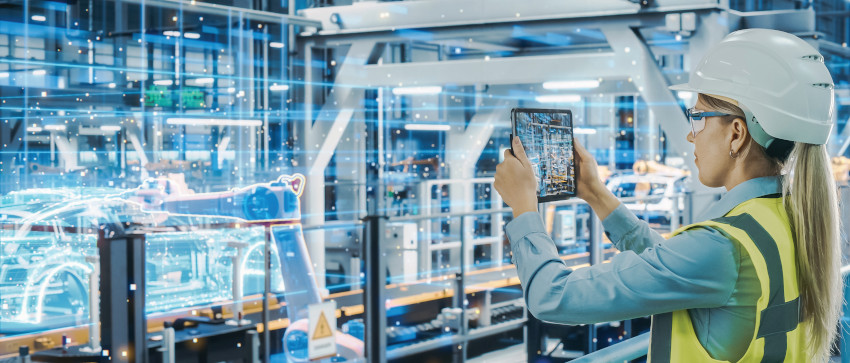
How Smart Devices Impact Manufacturing Productivity
By Eric Whitley
General Machine BuildingSmart, connected technologies are driving a seismic shift in manufacturing.

(Photo credit: Getty Images)
The transition from traditional manufacturing to this digital age is not merely a technological evolution but a paradigm shift that demands a rethinking of established norms and processes. The stakes are high, with the potential for significant gains in efficiency, quality and scalability, but also the risk of being left behind if one fails to adapt.
Engineers play a pivotal role in this transformation. They are the architects of this new digital landscape, responsible for integrating smart technologies into existing manufacturing processes.
This article covers the specific ways smart devices are revolutionizing manufacturing productivity, along with their challenges and opportunities. This section will dissect the role of smart devices in various manufacturing sectors.
Automotive
The automotive industry has been a pioneer in adopting smart technologies to enhance manufacturing processes. For example, the use of passive and wearable vest exoskeletons in automotive manufacturing is a game-changer. These devices, designed to support the musculoskeletal system, enable workers to perform tasks with reduced physical strain. For engineers, the challenge lies in customizing these exoskeletons to suit specific manufacturing tasks.
The enhanced human performance of the technologies above also has a direct impact on quality control. Engineers are leveraging data analytics to assess the performance improvements brought about by these devices, thereby ensuring that quality standards are consistently met.
Design and Engineering
Smart devices are also revolutionizing the way designers and engineers work. For example, connected worker technology, when integrated with augmented reality (AR), creates a collaborative environment where engineers can share real-time data and visualizations. This is particularly beneficial for OEMs who operate across multiple locations.
AR isn’t just a tool for visualization; it’s an optimization engine. Engineers use AR to perform virtual “dry runs” of designs, identifying potential bottlenecks or flaws before physical prototypes are built.
AR is also a powerful tool for training and skill development. Engineers can create immersive training modules that can be accessed remotely, ensuring that staff are uniformly trained, irrespective of their geographical location.
Prototyping with AR gives engineers the ability to project virtual prototypes into the real world and interact with their designs in a 3D space, making necessary adjustments before the product goes into production. This is a significant leap forward in reducing the time to market for new products.
Biomedical Devices
The biomedical sector is a high-stakes arena where precision and reliability are paramount. Smart devices are playing an increasingly crucial role in meeting these demands.
Robots equipped with smart sensors, for example, are becoming indispensable in the manufacturing of biomedical devices. Engineers are tasked with programming these robots to perform intricate tasks with micron-level precision.
Quality assurance is a critical aspect of the production process, given the life-saving nature of biomedical devices. Integrating smart sensors and machine learning algorithms to monitor the manufacturing process in real time allows for immediate corrective actions, ensuring that the end product meets all regulatory standards.
Smart devices generate a wealth of data that engineers can analyze to make informed decisions. Whether it’s optimizing the manufacturing process or predicting maintenance needs, data analytics is becoming a vital tool for engineers in the biomedical sector.
Given the stringent regulations in the biomedical field, engineers are leveraging smart devices to automate the documentation process so that all compliance requirements are met without human error.
Electronics
The electronics sector is characterized by rapid innovation and a constant push for miniaturization and functionality.
Automated soldering and assembly, using smart robots, is revolutionizing the way electronic components are assembled. Engineers are programming these robots to handle intricate soldering tasks to make sure connections are accurate and reliable.
Testing and quality control is another area where smart devices are making a significant impact. Engineers are using automated testing rigs equipped with smart sensors to perform a range of tests, from electrical conductivity to thermal resistance, ensuring that each product meets the required standards.
Real-time component tracking and inventory management, using smart devices equipped with RFID and barcode scanners, is particularly useful for managing complex supply chains and ensuring that the right components are available at the right time.
The next wave of innovations is already on the horizon. Some of these innovations include self-optimizing machines, decentralized manufacturing and further-augmented workers, all designed to support sustainable manufacturing.
The manufacturing landscape is rapidly evolving due to smart devices and technologies. The above is just a glimpse into what lies ahead and how engineers and OEMs will be central to these changes.
www.l2l.com
After an extensive career as a reliability and business improvement consultant, Eric Whitley joined L2L, where he currently serves as the Director of Smart Manufacturing.
